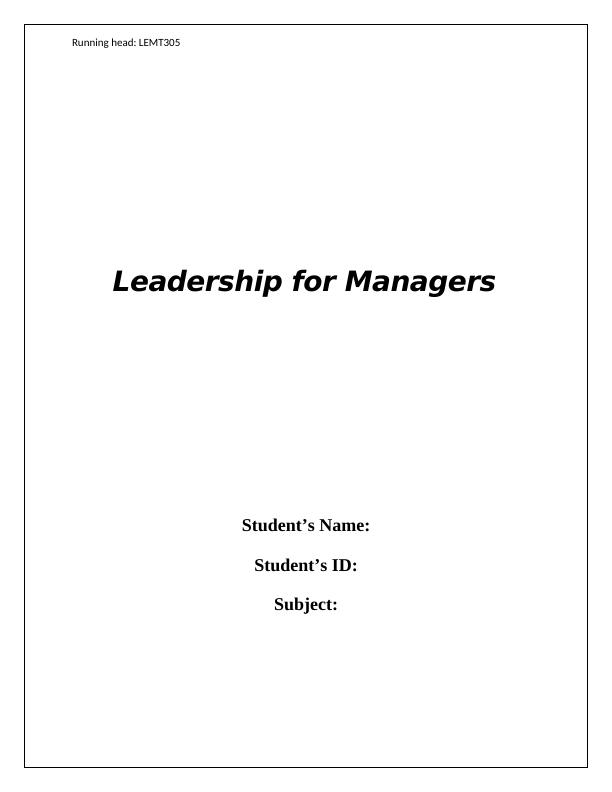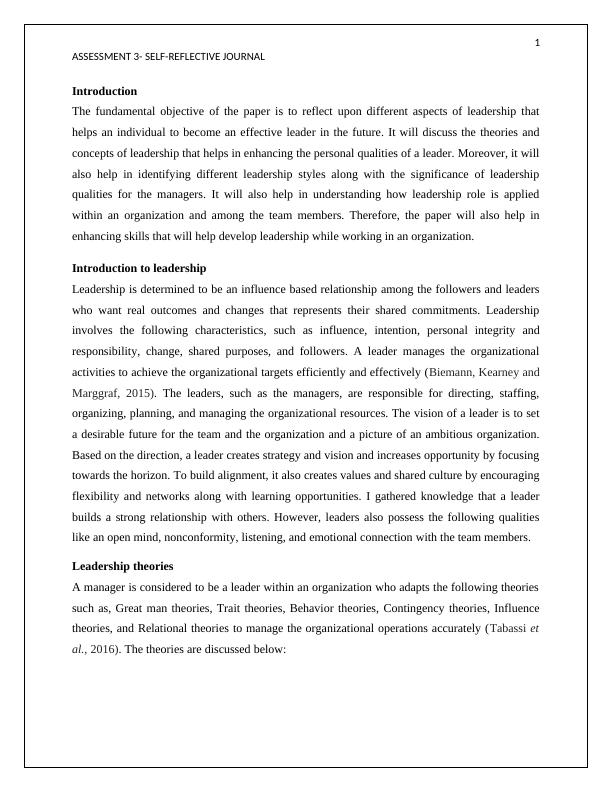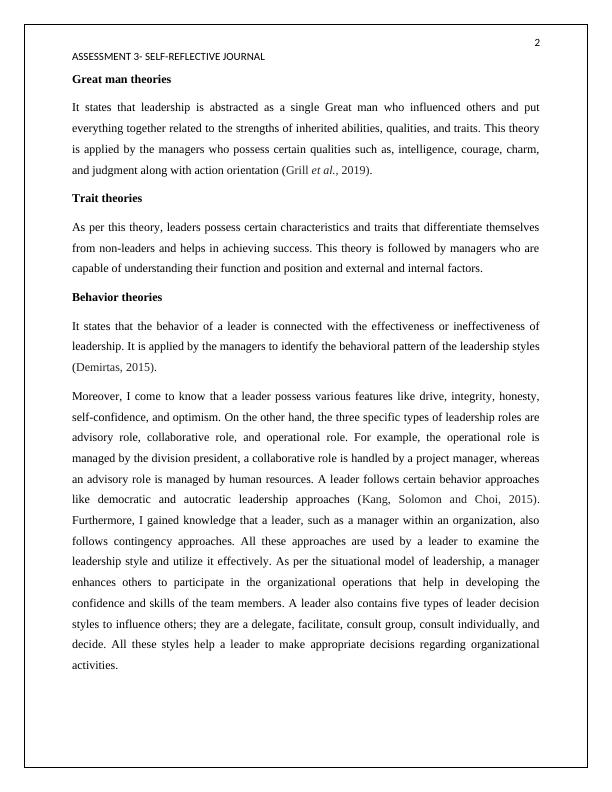Leadership for Managers
Added on 2023-03-30
9 Pages2517 Words301 Views
Running head: LEMT305
Leadership for Managers
Student’s Name:
Student’s ID:
Subject:
Leadership for Managers
Student’s Name:
Student’s ID:
Subject:

1
ASSESSMENT 3- SELF-REFLECTIVE JOURNAL
Introduction
The fundamental objective of the paper is to reflect upon different aspects of leadership that
helps an individual to become an effective leader in the future. It will discuss the theories and
concepts of leadership that helps in enhancing the personal qualities of a leader. Moreover, it will
also help in identifying different leadership styles along with the significance of leadership
qualities for the managers. It will also help in understanding how leadership role is applied
within an organization and among the team members. Therefore, the paper will also help in
enhancing skills that will help develop leadership while working in an organization.
Introduction to leadership
Leadership is determined to be an influence based relationship among the followers and leaders
who want real outcomes and changes that represents their shared commitments. Leadership
involves the following characteristics, such as influence, intention, personal integrity and
responsibility, change, shared purposes, and followers. A leader manages the organizational
activities to achieve the organizational targets efficiently and effectively (Biemann, Kearney and
Marggraf, 2015). The leaders, such as the managers, are responsible for directing, staffing,
organizing, planning, and managing the organizational resources. The vision of a leader is to set
a desirable future for the team and the organization and a picture of an ambitious organization.
Based on the direction, a leader creates strategy and vision and increases opportunity by focusing
towards the horizon. To build alignment, it also creates values and shared culture by encouraging
flexibility and networks along with learning opportunities. I gathered knowledge that a leader
builds a strong relationship with others. However, leaders also possess the following qualities
like an open mind, nonconformity, listening, and emotional connection with the team members.
Leadership theories
A manager is considered to be a leader within an organization who adapts the following theories
such as, Great man theories, Trait theories, Behavior theories, Contingency theories, Influence
theories, and Relational theories to manage the organizational operations accurately (Tabassi et
al., 2016). The theories are discussed below:
ASSESSMENT 3- SELF-REFLECTIVE JOURNAL
Introduction
The fundamental objective of the paper is to reflect upon different aspects of leadership that
helps an individual to become an effective leader in the future. It will discuss the theories and
concepts of leadership that helps in enhancing the personal qualities of a leader. Moreover, it will
also help in identifying different leadership styles along with the significance of leadership
qualities for the managers. It will also help in understanding how leadership role is applied
within an organization and among the team members. Therefore, the paper will also help in
enhancing skills that will help develop leadership while working in an organization.
Introduction to leadership
Leadership is determined to be an influence based relationship among the followers and leaders
who want real outcomes and changes that represents their shared commitments. Leadership
involves the following characteristics, such as influence, intention, personal integrity and
responsibility, change, shared purposes, and followers. A leader manages the organizational
activities to achieve the organizational targets efficiently and effectively (Biemann, Kearney and
Marggraf, 2015). The leaders, such as the managers, are responsible for directing, staffing,
organizing, planning, and managing the organizational resources. The vision of a leader is to set
a desirable future for the team and the organization and a picture of an ambitious organization.
Based on the direction, a leader creates strategy and vision and increases opportunity by focusing
towards the horizon. To build alignment, it also creates values and shared culture by encouraging
flexibility and networks along with learning opportunities. I gathered knowledge that a leader
builds a strong relationship with others. However, leaders also possess the following qualities
like an open mind, nonconformity, listening, and emotional connection with the team members.
Leadership theories
A manager is considered to be a leader within an organization who adapts the following theories
such as, Great man theories, Trait theories, Behavior theories, Contingency theories, Influence
theories, and Relational theories to manage the organizational operations accurately (Tabassi et
al., 2016). The theories are discussed below:

2
ASSESSMENT 3- SELF-REFLECTIVE JOURNAL
Great man theories
It states that leadership is abstracted as a single Great man who influenced others and put
everything together related to the strengths of inherited abilities, qualities, and traits. This theory
is applied by the managers who possess certain qualities such as, intelligence, courage, charm,
and judgment along with action orientation (Grill et al., 2019).
Trait theories
As per this theory, leaders possess certain characteristics and traits that differentiate themselves
from non-leaders and helps in achieving success. This theory is followed by managers who are
capable of understanding their function and position and external and internal factors.
Behavior theories
It states that the behavior of a leader is connected with the effectiveness or ineffectiveness of
leadership. It is applied by the managers to identify the behavioral pattern of the leadership styles
(Demirtas, 2015).
Moreover, I come to know that a leader possess various features like drive, integrity, honesty,
self-confidence, and optimism. On the other hand, the three specific types of leadership roles are
advisory role, collaborative role, and operational role. For example, the operational role is
managed by the division president, a collaborative role is handled by a project manager, whereas
an advisory role is managed by human resources. A leader follows certain behavior approaches
like democratic and autocratic leadership approaches (Kang, Solomon and Choi, 2015).
Furthermore, I gained knowledge that a leader, such as a manager within an organization, also
follows contingency approaches. All these approaches are used by a leader to examine the
leadership style and utilize it effectively. As per the situational model of leadership, a manager
enhances others to participate in the organizational operations that help in developing the
confidence and skills of the team members. A leader also contains five types of leader decision
styles to influence others; they are a delegate, facilitate, consult group, consult individually, and
decide. All these styles help a leader to make appropriate decisions regarding organizational
activities.
ASSESSMENT 3- SELF-REFLECTIVE JOURNAL
Great man theories
It states that leadership is abstracted as a single Great man who influenced others and put
everything together related to the strengths of inherited abilities, qualities, and traits. This theory
is applied by the managers who possess certain qualities such as, intelligence, courage, charm,
and judgment along with action orientation (Grill et al., 2019).
Trait theories
As per this theory, leaders possess certain characteristics and traits that differentiate themselves
from non-leaders and helps in achieving success. This theory is followed by managers who are
capable of understanding their function and position and external and internal factors.
Behavior theories
It states that the behavior of a leader is connected with the effectiveness or ineffectiveness of
leadership. It is applied by the managers to identify the behavioral pattern of the leadership styles
(Demirtas, 2015).
Moreover, I come to know that a leader possess various features like drive, integrity, honesty,
self-confidence, and optimism. On the other hand, the three specific types of leadership roles are
advisory role, collaborative role, and operational role. For example, the operational role is
managed by the division president, a collaborative role is handled by a project manager, whereas
an advisory role is managed by human resources. A leader follows certain behavior approaches
like democratic and autocratic leadership approaches (Kang, Solomon and Choi, 2015).
Furthermore, I gained knowledge that a leader, such as a manager within an organization, also
follows contingency approaches. All these approaches are used by a leader to examine the
leadership style and utilize it effectively. As per the situational model of leadership, a manager
enhances others to participate in the organizational operations that help in developing the
confidence and skills of the team members. A leader also contains five types of leader decision
styles to influence others; they are a delegate, facilitate, consult group, consult individually, and
decide. All these styles help a leader to make appropriate decisions regarding organizational
activities.

End of preview
Want to access all the pages? Upload your documents or become a member.
Related Documents
Historical Development of Leadership and Managementlg...
|6
|1376
|10
Report on Leadeship Style of Elon Musklg...
|11
|3551
|133
This reflective report focuses on different conceptslg...
|8
|2846
|14
Leadership Theorieslg...
|5
|1050
|22
Leadership Theorieslg...
|5
|1056
|51
Leadership and Management: A Study on Trait Theory and Leadership Styleslg...
|28
|2593
|379
